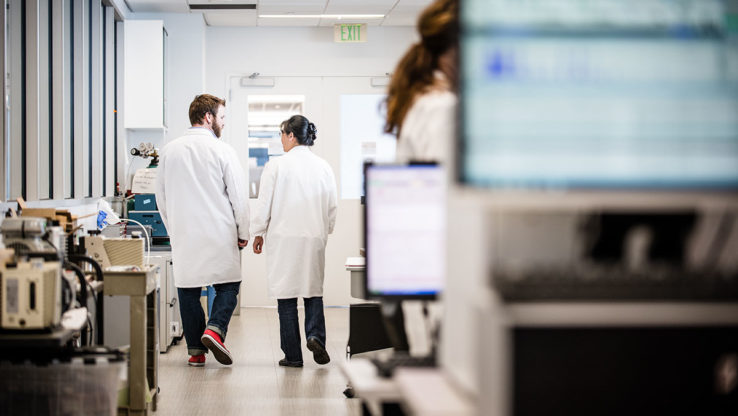
Wilke Cohen Lyme Disease Project
ISB researchers have put their efforts into looking at Lyme disease and the bacteria, Borrelia burgdorferi, that causes the disease, through the lens of systems biology, and utilizing approaches pioneered at ISB to gather, synthesize and interpret large and complex datasets.

Identification of the proteins in Plasmodium vivax provide new targets for a malaria vaccine
Scientists from ISB and the Center for Infectious Disease Research led an international collaboration to identify proteins in the malaria parasite Plasmodium vivax. P. vivax and P. falciparum cause the majority of malaria cases, but P. vivax is far less-studied, in part because it cannot be grown in the lab. The research aims to provide new targets for a malaria vaccine.

Proteomics: Identifying Organ-Specific Blood Biomarkers for Acute Liver Injury
To assess probable injury to an organ, it is important to monitor biologic materials that originate exclusively or primarily in that organ, in this case, liver-enriched proteins.

Quantitating the Complete Human Proteome
ISB scientists collaborate with ETH Zurich to develop the Human SRMAtlas, a compendium of mass spectrometry assays for any human protein.

Scratching the Surface of the Malaria Parasite
Surface coat proteins on Plasmodium, the parasite that causes malaria, provide new targets for a malaria vaccine. ISB scientists collaborate with scientists from Center for Infectious Disease Research and Johns Hopkins University to identify new proteins on the surface of the malaria parasite Plasmodium.
The research aims to provide new targets for a malaria vaccine.
It is discovered that some Plasmodium surface proteins have sugar attachments that can cloak these proteins from the human immune system.

Ötzi the Iceman: Helicobacter pylori Pathogen Found in Stomach Contents
Institute for Systems Biology collaborates with researchers worldwide to study pathogens in the stomach content and microbiome of the 5300 year old European Copper Age glacier mummy “Ötzi” and discovers a Helicobacter pylori pathogen genome.
Ötzi harbored a nearly pure Asian-origin bacterial population of H. pylori providing key information as to population migration into Europe over the last few thousand years.
Supported by proteome information gathered at ISB, the Iceman’s stomach was found to be colonized by a cytotoxic strain of H. pylori that triggered host inflammation immune responses.

Researchers determine architecture of a macromolecular complex regulating gene expression and DNA repair
The expression, or transcription, of genes controls the identity and function of a cell. DNA damage caused by UV light or other carcinogens must be repaired to maintain genome integrity. The general transcription factor TFIIH plays central roles in both processes and is also important to couple gene transcription with DNA repair. Researchers at the Institute for Systems Biology, in collaboration with the University of California, San Francisco, the University of Colorado Boulder, and the Fred Hutchinson Cancer Research Center, have mapped the architecture of the multi-subunit TFIIH complex. This research, published online in Molecular Cell on Sept. 4, 2015, represents a breakthrough in understanding the structural basis for transcription and DNA repair, and provides critical insights into how disruption of the TFIIH complex can lead to cancer and other diseases.

ISB Releases Open-Source Software to Analyze Digital Fingerprint of Protein Data
SWATH mass spectrometry, an emerging protein analysis technique being pioneered by ISB researchers, provides a digital fingerprint of all accessible proteins in a sample.
The data generated by the SWATH technique are highly complex and require sophisticated computational tools in order to extract identities from a sea of data.
ISB researchers have released a free, open source program that allows users to confidently identify and quantify proteins analyzed by SWATH

Identifying markers of healthy skin development
The barrier function of skin is integral to personal well-being and is associated with several widespread diseases such as eczema and psoriasis.
ISB and Procter & Gamble researchers used human skin grown in the lab to measure changes in protein levels as the skin matures.
The results of this study provide many new markers for healthy skin development.

Into the Genetic Weeds of Hair Growth
ISB researchers used a data-driven mathematical model to identify specific genes associated with hair regeneration.
Novel methodology paves way for continued research into the molecular basis of this complex cycle as well as other regenerative organs like skin and liver.
Findings may lead to more precise targets for therapies and genetic markers of hair wellness.

Let Us Tell You Everything We Know About Proteomics – Everything
Proteomics experiments generate huge amounts of raw data, most of which cannot be easily shared or described in a publication.
ISB researchers curate publicly accessible databases that allow researchers to share their data with the world and to use data others have collected.
All data are analyzed in a consistent manner and results are presented via searchable, user-friendly web applications.

A New Approach to Identifying How the Deadly Dengue Virus Multiplies
Dengue virus is the most prevalent mosquito-borne virus worldwide, infecting an estimated 400 million people per year and causing about 25,000 deaths.
It’s necessary to understand the molecular mechanisms of dengue replication in order to develop an effective treatment.
Researchers at ISB and Seattle BioMed developed a novel approach for identifying host proteins that associate with dengue replication machinery.

New Structural Map Helps To Understand Aggressive Tumors
Aggressive tumor growth is linked to high activity of a macromolecular assembly called RNA polymerase I.
ISB and FHCRC researchers collaborate to map the architecture of the assembly using a powerful crosslinking-mass spectrometry (CXMS) technology.
Structural maps provide important insights into therapeutic targets for cancer treatment.

New Protein Modification Critical to Growth of Tuberculosis Pathogen Found
Institute for Systems Biology and Seattle BioMed researchers collaborated and discovered a new protein post-translational modification in the human pathogen Mycobacterium tuberculosis.
Post-translational modifications are essential mechanisms used by cells to diversify protein functions and ISB scientists identified the rare phosphorylated tyrosine post translational modification on Mycobacterium tuberculosis proteins using mass spectrometry.
Inhibiting phosphotyrosine modified amino acids in Mycobacterium tuberculosis severely limits the growth of this widespread deadly pathogen.

The Rise of Open Proteomics
Researchers at EMBL-EBI, Institute for Systems Biology and other partnering organizations have launched ProteomeXchange, a public portal for exchanging proteomics data generated from mass-spectrometry experiments and other related information.

The Bug Stops Here: Arresting Malaria Parasites in the Liver Gives Immunity
ISB researchers collaborated with Seattle BioMed researchers to identify molecular building blocks required by malaria parasites to build cell membranes.
Deleting key genes necessary for building cell membranes created a parasite that does not make the host sick and can’t be passed on through the blood.
Treating mice with modified parasites gave them complete immunity against malaria.

ISB’s PeptideAtlas Helps Advance the Study of Proteins
The Human Proteome Project expands on the work of the Human Genome Project.
ISB is a leader in proteomics and developed PeptideAtlas, a project that has cataloged the proteins observed in thousands of proteomics experiments as an open resource for researchers everywhere.
In a new report, ISB researchers show that PeptideAtlas now contains proteins from about 62 percent of human genes thought to encode proteins.

Systems Approach to Innovation Helps Extract More Data
Technology lag affects the study of proteins, which when quantified can indicate disease or wellness.
ISB uses systems approach to innovate and transcend technology limitations.
ISB co-develops new technique and software suite to increase protein detection rate.



